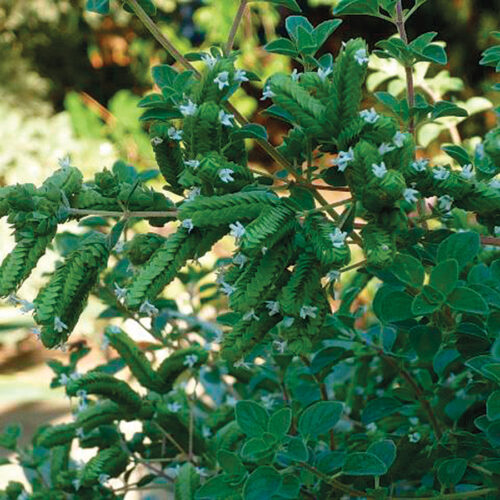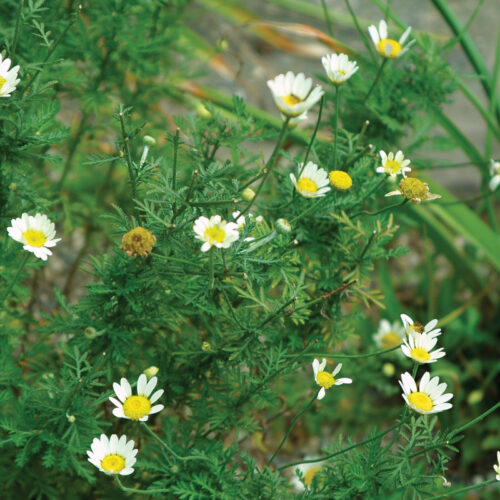No garden is complete without herbs. Not only are they attractive plants, but they also taste phenomenal. Herbs can be either annual (like dill or cilantro), or perennial (like sage or rosemary). Starting them from seed isn’t hard, but each individual plant has its own set of quirks. Read on to get insight on which herbs are the easiest to grow and how to ensure that your germination rate is stellar. Learn more: All about growing herbs.
 |
Dill
Name: Anethum graveolens
Hardiness: Annual
Size: Up to 3 feet tall and 1 foot wide
Use: It has highly aromatic, edible foliage
and seeds.
Days to germinate: 14 to 21
Germination conditions: For the best results, direct-sow in late spring when temperatures remain above 45°F. The plant does not transplant easily because of its long taproot.
Growing instructions: Plant in full sun and in well-drained soil. Space 8 to 12 inches apart.
Herb note: It readily self-sows and can become a nuisance. Do not plant dill near fennel because they may hybridize. |
 |
Chervil
Name: Anthriscus cerefolium
Hardiness: Annual
Size: 1 to 2 feet tall and 10 inches wide
Use: Its fernlike leaves have a slight licorice flavor and can be used as a substitute for parsley.
Days to germinate: 14 to 21
Germination conditions: Direct-sow in spring when temperatures are consistently above 45°F.
Growing instructions: Plant in partial shade and in well-drained soil. Space 8 inches apart.
Herb note: Pinch back emerging flower shoots to prolong the foliage harvest. |
 |
Caraway
Name: Carum carvi
Hardiness: Biennial in USDA Hardiness Zones 3 to 9
Size: 2 feet tall and 1 foot wide
Use: It is grown for its anise-flavored seeds, but its carrotlike foliage is also edible.
Days to germinate: 14 to 21
Germination conditions: Sow seeds outdoors in late spring when temperatures are consistently above 45°F. It can be started indoors, but it is better to direct-sow because it is difficult to transplant.
Growing instructions: Plant in full sun and in well-drained, fertile soil.
Herb note: Harvest seeds in late summer before they self-disperse. Shake the seed heads into a bag, or cut them off and hang them up to mature and dry. |
 |
Marjoram
Name: Origanum majorana
Hardiness: Annual
Size: 1 to 2 feet tall and wide
Use: Its leaves are edible when fresh, or they can be dried and stored for later use.
Days to germinate: 10 to 15
Germination conditions: Direct-sow in late spring after all danger of frost has passed. Start indoors three to four weeks before the last frost; do not plant out until all danger of frost has passed.
Growing instructions: Plant in full sun and in light, well-drained soil. Water regularly in the early stages of growth. Thin seedlings to 12 inches apart.
Herb note: When the flowers start drying on the plant, cut the seed heads off and place them in a paper bag. After two weeks, remove the seeds from the dried flower heads. Sift or blow the seeds from the chaff. |
 |
Chives
Name: Allium schoenoprasum
Hardiness: Zones 5 to 11
Size: 1 to 2 feet tall and wide
Use: Although the entire plant is edible, the foliage is most often used to flavor various dishes.
Days to germinate: 10 to 20
Germination conditions: Sow outdoors in late spring once night temperatures are above 45°F but while the soil is still cool. Sow indoors in spring six weeks before planting out.
Growing instructions: Plant in full sun and in well-drained soil. Space 12 inches apart.
Herb note: Regularly trim mild, onion-flavored growth to an inch above the base for fresh use or to dry and store. |
 |
Fennel
Name: Foeniculum vulgare and cvs.
Hardiness: Zones 4 to 9
Size: 4 to 6 feet tall and 2 feet wide
Use: It is appreciated for its aromatic, fine-textured foliage; bulbous, anise-flavored root; and sweet seeds.
Days to germinate: 14 to 20, outdoors; 7 to 10, indoors
Germination conditions: Direct-sow outdoors in spring when temperatures are consistently above 45°F. Start indoors four to six weeks before the last frost.
Growing instructions: Plant in full sun and in well-drained, sandy loam. Cooler fall temperatures are needed for the bulb to develop. Thin seedlings to 12 to 15 inches apart.
Herb note: Plant with caution—fennel is invasive in some regions. To collect the seeds, allow them to ripen and dry on the stem, shake them into a bag, and store them in a dry place. |
 |
Coriander/cilantro
Name: Coriandrum sativum
Hardiness: Annual
Size: 16 to 20 inches tall and 10 inches wide
Use: It has aromatic, edible leaves (cilantro) and seeds (coriander).
Days to germinate: 14 to 21
Germination conditions: Sow directly in the ground once temperatures do not dip below 45°F.
Growing instructions: Plant in full sun and in well-drained soil. Thin to 8 inches apart.
Herb note: Pinch back or harvest new leaves regularly to prevent bolting. To harvest the coriander seeds, allow the herb to go to seed and let the pods dry on the plant. Harvest the seed heads, and let them dry for a week before storing. |
 |
Common thyme
Name: Thymus spp. and cvs.
Hardiness: Zones 4 to 9
Size: Up to 1 foot tall with a creeping habit
Use: Harvest foliage anytime before it flowers. Use fresh, or dry and store.
Days to germinate: 5 to 10
Germination conditions: Sow indoors, uncovered, eight to 10 weeks before the last frost. Water from the bottom.
Growing instructions: Plant in full sun and in well-drained soil.
Herb note: Harvest about 3 to 4 inches of growth several times a year to prevent the plant from becoming woody. |
 |
Sage
Name: Salvia officinalis and cvs.
Hardiness: Zones 5 to 8
Size: Up to 2 feet tall, spreading to 1 to 2 feet
Use: It is grown for its aromatic, savory leaves.
Days to germinate: 7 to 14
Germination conditions: Sow indoors in spring six to eight weeks before the last frost, and cover the seeds with soil.
Growing instructions: Plant in full sun and in fertile, well-drained soil. Space 12 to 18 inches apart.
Herb note: Pinch back to promote compact growth. Harvest leaves for fresh use or to dry and store for later use. |
 |
Mint
Name: Mentha spicata
Hardiness: Zones 3 to 7
Size: 18 to 36 inches tall with an indeterminate spread
Use: Its edible leaves are a tasty addition to drinks and dishes.
Days to germinate: 15 to 20
Germination conditions: Sow indoors four to six weeks before the last frost. Do not cover seeds with soil. Water from the bottom. Sow outdoors after the danger of frost has passed but while the soil is still cool.
Growing instructions: Plant in full sun to partial shade and in well-drained soil. Space 18 to 24 inches apart.
Herb note: It is renowned for being aggressive, so plant with care in a confined area. |
 |
Parsley
Name: Petroselinum crispum and cvs.
Hardiness: Biennial in Zones 5 to 9, usually grown as an annual
Size: 1 to 2 feet tall, spreading to 1 to 2 feet
Use: It has mild-flavored, bright green foliage.
Days to germinate: 14 to 28
Germination conditions: Soak seeds prior to sowing. It’s best to direct-sow in a moist seedbed in late spring, but it can be started indoors eight weeks before planting out.
Growing instructions: Plant in full sun to partial shade and in consistently moist soil.
Herb note: It readily self-sows. Seeds do not store well. |
 |
Oregano
Name: Origanum vulgare and cvs.
Hardiness: Zones 4 to 9
Size: 6 to 18 inches tall and 18 inches wide
use: It has savory, dark green leaves.
Days to germinate: 10 to 15
Germination conditions: Sow indoors, uncovered, in spring six to eight weeks before the last frost. Direct-sow after all danger of frost has passed and the ground is warm; lightly cover the seeds with soil.
Growing instructions: Plant in full sun and in fertile, well-drained soil. Space 18 inches apart. It is drought tolerant.
Herb note: Sheer plants to the ground if they get leggy. For fresh or dried use, harvest just before the herb flowers. |
 |
Roman chamomile
Name: Chamaemelum nobile
Hardiness: Zones 6 to 9
Size: 1 to 2 feet tall and wide
Use: The foliage and flowers are edible—fresh or dried.
Days to germinate: 14 to 20
Germination conditions: Sow indoors, uncovered, about six weeks before the last frost. Sow outside in spring after all danger of frost has passed.
Growing instructions: Plant in full sun and in dry, rich soil. Space 6 to 12 inches apart.
Herb note: It produces fewer flowers when it’s grown in partial shade. Harvest flowers when they are in full bloom, hang upside down to dry, and store for later use. |
 |
Borage
Name: Borago officinalis
Hardiness: Annual
Size: 2 to 3 feet tall and 18 to 24 inches wide
Use: It has cucumber-flavored leaves and flowers.
Days to germinate: 7 to 10
Germination conditions: Direct-sow in fall or early spring. It self-sows readily.
Growing instructions: Plant in full sun; it tolerates most soil conditions. Thin seedlings
to 18 inches apart.
Herb note: Allow the plant to self-sow, or collect the seeds when the seedpods turn brown but before they shatter. |
 |
Rosemary
Name: Rosmarinus officinalis and cvs.
Hardiness: Zones 8 to 11
Size: Up to 4 feet tall and wide
Use: The leaves are a wonderful seasoning for salads and entrees.
Days to germinate: 7 to 14
Germination conditions: Sow indoors six to eight weeks before the last frost. Do not plant out until all danger of frost has passed.
Growing instructions: Plant in full sun and in well-drained soil. Space 18 to 24 inches apart.
Herb note: Seedlings are susceptible to damping off, so don’t overwater. |





















Comments
My roofer suggested I plant plants on my roof
Log in or create an account to post a comment.
Sign up Log in